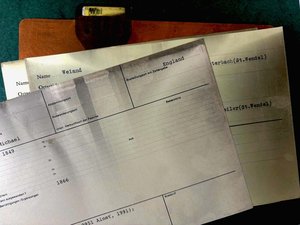The Migration Database of IPGV
Beginnings in the Nazi Era
In parallel with the institute's history, the origins of the Migration Database also date back to the Nazi era. Aligned with the Nazi racial ideology, the task of the "Mittelstelle Saarpfalz – Landsleute drinnen und draußen," founded in 1936, was to investigate the "family and emigrant history" and establish a research and documentation center for Palatinate migration genealogy. In this context, the names of emigrated Palatines were recorded: by 1940, there were already about 100,000 migration movements documented on alphabetically sorted index cards.
During the war, the Mittelstelle's work was halted, and the facility was completely closed by the US authorities after the war. However, the work on the database continued after the war with great personnel continuity, often surprising from today's perspective: Fritz Braun, the returning head of the "Mittelstelle," became the head of the new institution, now called "Heimatstelle Pfalz." He progressively expanded the database of migration movements, which had suffered significant losses during the war, in the post-war period.

Modernization and Initial Digitization Attempts
This expansion continued with personnel and content modernization in the subsequent period. Data on immigrants and emigrants from (short-)Palatinate localities were collected and recorded on index cards based on various sources such as ship or emigration lists and church records.
As early as the early 1990s – at least before 1991 – digitizing migration data was considered. The core of a very elaborate conceptual planning for that time, which unfortunately was never practically implemented, was an institute-internal database server, through which users from local clients should be able to submit research requests. It was noted back then that digitizing analog index cards would allow searching for information "not only on the actual person, as before, but also on their surroundings," which, in turn, would "significantly increase the value of qualitative evaluation," according to the digitization concept. Although the digitization of migration data was intended to be transferred to this database due to the mentioned advantages, it remained only a theoretical concept. The first data capture on a specially developed platform, which took place from 1995 to 1998 with a greatly reduced concept, was paused for technical and personnel reasons until the mid-2000s. It was only resumed at the end of 2004 and ended again in the mid-2010s.

Fire Damage and New Digitization Concept
During the institute's fire in 2019, the card collection was in the midst of the immediate fire, suffering severe damage, making research in the original collections no longer possible. The smoke, in particular, affected the index cards and led to irreversible damage. The cards were saved by creating image digitizations. While the modernization of digitization work had already been initiated by Dr. Sabine Klapp, who led the institute from 2017, before the fire, these efforts were intensified after the fire to enable research in the data despite the unusability of the index cards. The fundamental redevelopment of the database structure, the transfer of the already generated data into it, and the creation of a research platform were undertaken by Dr. Maximilian Lässig, the scientific employee responsible for digitization and digital development at the institute since 2021. Since November 2023, the IPGV card collection can be freely accessed as the Beta version of the Digitale Migrationskartei (Digital Migration Database). For more information on this project, please visit here or directly on the Digital Migration Database page at migration.pfalzgeschichte.de.